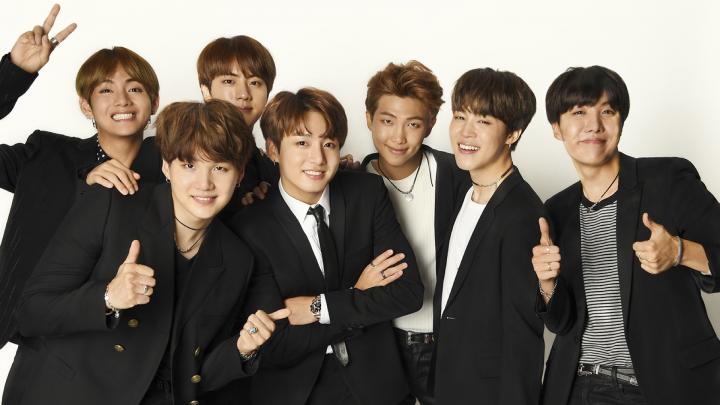

With the recent global success of Korean music bands such as BTS and BlackPink, Korean Pop (K-pop) is no longer just a sub-cultural phenomenon born out of South Korea. Just like Beyoncé’s Bey Hive or Lady Gaga’s Little Monsters, k-pop bands today are backed by the support of devout fans such as the ARMY (Adorable Representative M.C. for Youth – a fan group made up of South Korean boy band BTS’s fervent followers). The ARMY is devoted to their idol, and has even become a much more formidable force compared to fan groups of Western artists. Record-breaking social media reign, chart-topping music, and sold-out concerts, all thanks to the enthusiasm of ARMY all around the world, have solidified BTS as the world’s biggest boy band with an infectious brand reach that makes anything it touches, including merchandise, cosmetics, and even comics, highly sought after items.
When so much is on the line, having a recognizable name is essential for these pop music groups. We at Labbrand consider naming a critical step in the branding process: A brand’s name is a gateway and carrier to all brand equity. Previously, we shared how Korean culture impacted the naming of the country’s most internationally recognized brands. Now we ask ourselves: what is a successful brand name for a K-pop band? From a broader perspective, what can other brands learn from the K-pop naming strategy?
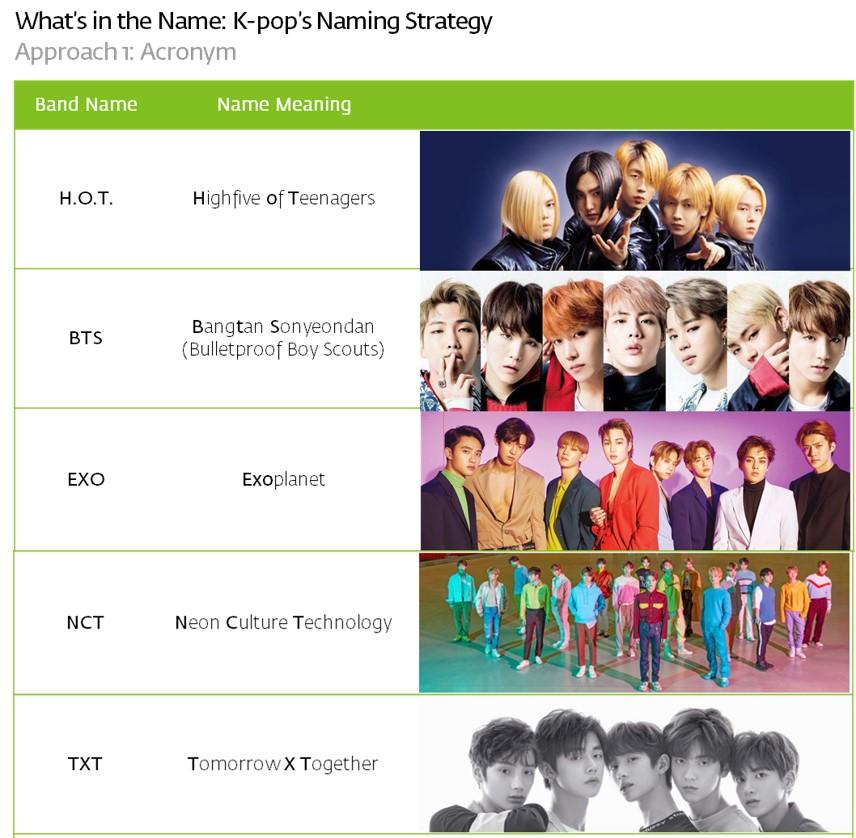
The most commonly adapted naming strategy for K-pop bands is initialism, or the acronym. This was used by one of the very first boy-bands, H.O.T., that have emerged from the Korean Wave, and is now famously used by BTS.
H.O.T. is an acronymic play on the concept of “Highfive Of Teenagers” and the word “hot”. The band and its concept were formed in 1996 partly based on a poll conducted among high school students to find out what their ideal pop group would be like. Similarly, the name BTS is based on the phrase “Bangtan Sonyeondan”, Romanized Korean for “Bulletproof Boy Scouts”. As BTS is often used to acronymize “Behind-The-Scenes” in English, it subsequently evolved as a backronym for “Beyond the Scene” in 2017, four years after the band was formed.
The main benefit of using an acronym is that it is short and easy to remember, which appeals to both the Korean-speaking and international audience. The very fact that the acronym itself doesn’t make much sense at first glance draws curiosity, giving the band the opportunity to use the name as a gateway to explain the underlying concept and even further build and evolve the brand overtime.
From 1996 to 2018, youth is a recurring motif behind the most popular K-pop bands. After all, their most loyal fanbase largely consisted of high school teenagers. But as K-pop’s audience grew larger, more international, and more diverse, K-pop is starting to look beyond youth. This is apparent in recent examples. The 2 latest bands represented by SM Entertainment – the same company responsible for H.O.T.’s success – both point to the jump away from youth. EXO was formed in 2012 with the name short for the term “exoplanet”. Later, in 2016, came NCT, which stands for “Neo Culture Technology”. Perhaps the name of BTS’s upcoming brother band, TXT, only the second act created by Big Hit Entertainment following BTS, sums it the best. TXT, or “Tomorrow X Together”, hints at what the future of Korean popular culture is all about.
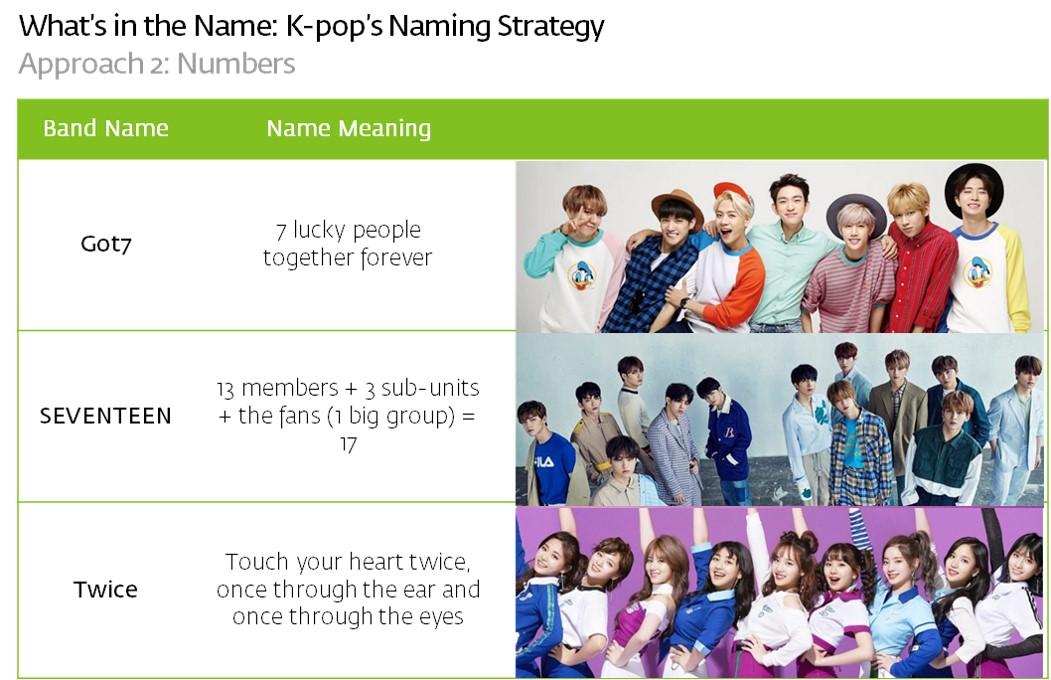
It seems natural that K-pop group would like to use numbers in their names. Numbers can serve as a universal language and indicate the number of members in the band. For example, the number “7” in the boy band Got7, not only refers to the 7 members in the group, but is also regarded by many in Asia as a lucky number.
However, some k pop bands’ numerical name go beyond its literal meaning. The number 17 of the boy band SEVENTEEN may lead you to conclude that there are 17 members in the band or the band’s concept is about being eternally 17-year-old. But in fact, it represents 13 members + 3 sub-units (hip-hop, vocal, and performance) + the fans (1 big group) = 17. Its concept broke tradition and included the fans into the narrative of the band’s concept. Another example of this is the highest-selling K-pop girl group in recent years Twice, whose name means the group would like to “touch your heart twice” – once through the ear and once through the eyes.
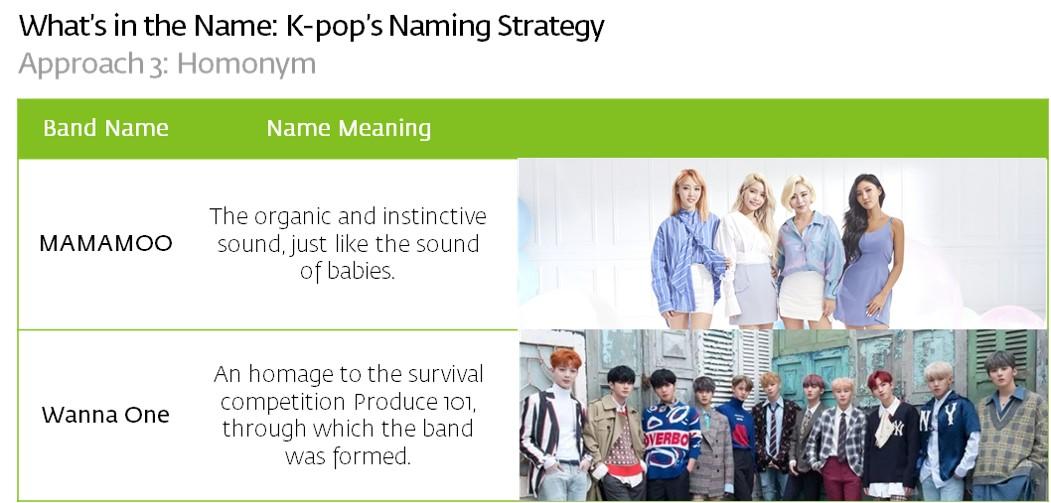
While meaning is important when it comes to verbal identity, the appeal of sound can elevate the brand further if it is easy to pronounce and remember, especially if those sounds resemble what all of us first learned to make when we were infants. Girl group MAMAMOO’s name mimics the sound that babies make, the concept being that they want to approach the listeners organically and instinctively with their music.
The sounds of “ah” and “aw” also appear in the name of Wanna One, the boy band with 11 members formed through the survival reality television show Produce 101. The aspirational name also pays homage to the sound of “101”.
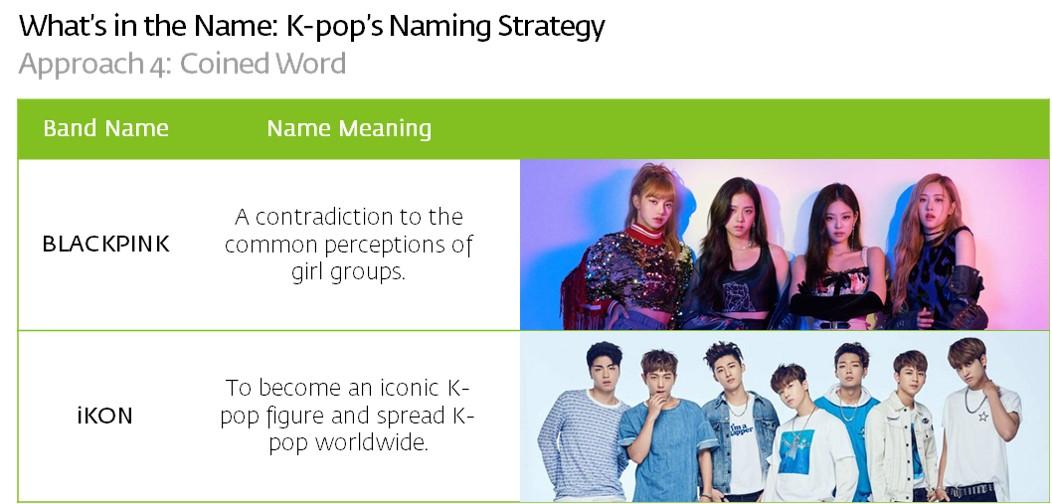
It seems that the winning strategy for a girl group has always been to appear pretty, sweet, and girly. If there were a color to describe this image, it’s pink. But with recent feminist campaigns breaking gender stereotypes all around the world, the “pink” dynamic in K-pop is also evolving.
This trend gave birth to BLACKPINK, a girl group made up of 4 members whose music is heavily influenced by EDM and hip-hop. BLACKPINK is a coined word that not only looks and sounds novel, but also aims to contradict the common perception of the color pink. The name intends to reflect the idea that being pretty is not everything and that the k-pop group also has great talent.
Another example of coined word is the k-pop naming of iKON. As K-pop is becoming more global, the boy k pop band simply replaced the letter ‘c’ with a ‘k’ in the word ‘icon’, reflecting their ambition to become an iconic K-pop figure and spread K-pop worldwide.
BTS is not the only K-pop band to have broken through the language gap and started to gain a global fanbase. Known for their dynamic audiovisual performances, impeccable choreography, and bedazzling fashion, K-pop groups are meticulously created and managed in ways similar to how many successful brands operate. A holistic branding process has propelled K-pop from “Gangnam Style” to become a billion dollar industry.
An important part of this process includes establishing a verbal identity by way of the band name. The brand name is the first thing you see, hear, and experience. It is also a reflection of the brand concept and proposition that aims to be distinct and relevant. Acronym, homonym, numbers, and coined words may not be groundbreaking naming strategies, but what has helped K-pop break into the global pop music scene is how each name tells a perfect story – a fairy tale that you can and should experience in person.
A Labbrand Group Company © 2005-2024 Labbrand All rights reserved
沪ICP备17001253号-3* Will be used in accordance with our Privacy Policy
To improve your experience, we use cookies to provide social media features, offer you content that targets your particular interests, and analyse the performance of our advertising campaigns. By clicking on “Accept” you consent to all cookies. You also have the option to click “Reject” to limit the use of certain types of cookies. Please be aware that rejecting cookies may affect your website browsing experience and limit the use of some personalised features.